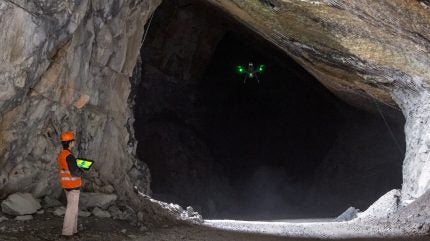
Future of work technologies – comprising the categories of visualisation, automation, interpretation, collaboration and connectivity – are playing a crucial role in improving safety within the mining industry, a new report outlines.
GlobalData’s The Future of Work in Mining report states that automation in particular is helping to improve mining safety by removing workers from dangerous jobs.
“Working in the mining sector will, and already does, involve using automated equipment across all points of the mining process,” it explains. “Automated or remote-controlled equipment can drill blast boreholes without human intervention. Autonomous trucks can take ore from sites to processing facilities, and autonomous trains can take the finished product to ports hundreds of kilometres away.”
The report notes that automation technology like drones, autonomous haulage systems (AHSs), autonomous or remote-controlled mining equipment and robots are already being adopted within the industry to improve productivity and safety.
“These technologies reduce costs in the long run and prevent workplace accidents by reducing the time workers spend in dangerous environments,” it says. “AHS removes human error and fatigue from ore haulage while increasing productivity through constant availability. 3D printing allows mining companies to print equipment, including personal protective equipment, supporting more efficient inventory management closer to home.”
The impact of automation in the form of robotics on safety is being recognised within the industry. The report references a GlobalData poll that found 36% of mining industry experts believe that robotics will have the greatest impact on safety. Only ‘improving productivity’ was found to be viewed as a bigger impact at 37%.
Elsewhere, the report notes that visualisation also has a role to play in improving safety by realistically simulating hazardous working environments for training and preparation.
“Digital twins of mining sites help companies test new methodologies and plan schedules while allowing for predictive maintenance, ultimately optimising the mining process,” the report says. “Augmented reality and virtual reality platforms allow for more realistic visual simulations, resulting in workers who are better prepared for emergency scenarios like cave-ins and malfunctions.”
Aidan Knight, associate analyst at GlobalData and author of the company’s The Future of Work in Mining report, commented: “Over the past thirty years, the mining sector has made significant strides in enhancing safety measures. Despite these improvements, the industry continues to present considerable risks, contributing to an increasingly pronounced skills shortage.
“Our Future of Work framework outlines technologies poised to markedly enhance safety records and bolster the industry’s appeal to potential employees. The integration of industrial automation, including autonomous haulage and workflow automation, has the potential to significantly reduce the exposure of workers to hazardous conditions. Additionally, the implementation of wearable technology offers the capability to monitor employees’ health and fatigue levels in real time.”
Knight added that investing in future of work technologies not only improves safety for mining companies but helps them to maintain a competitive advantage.




